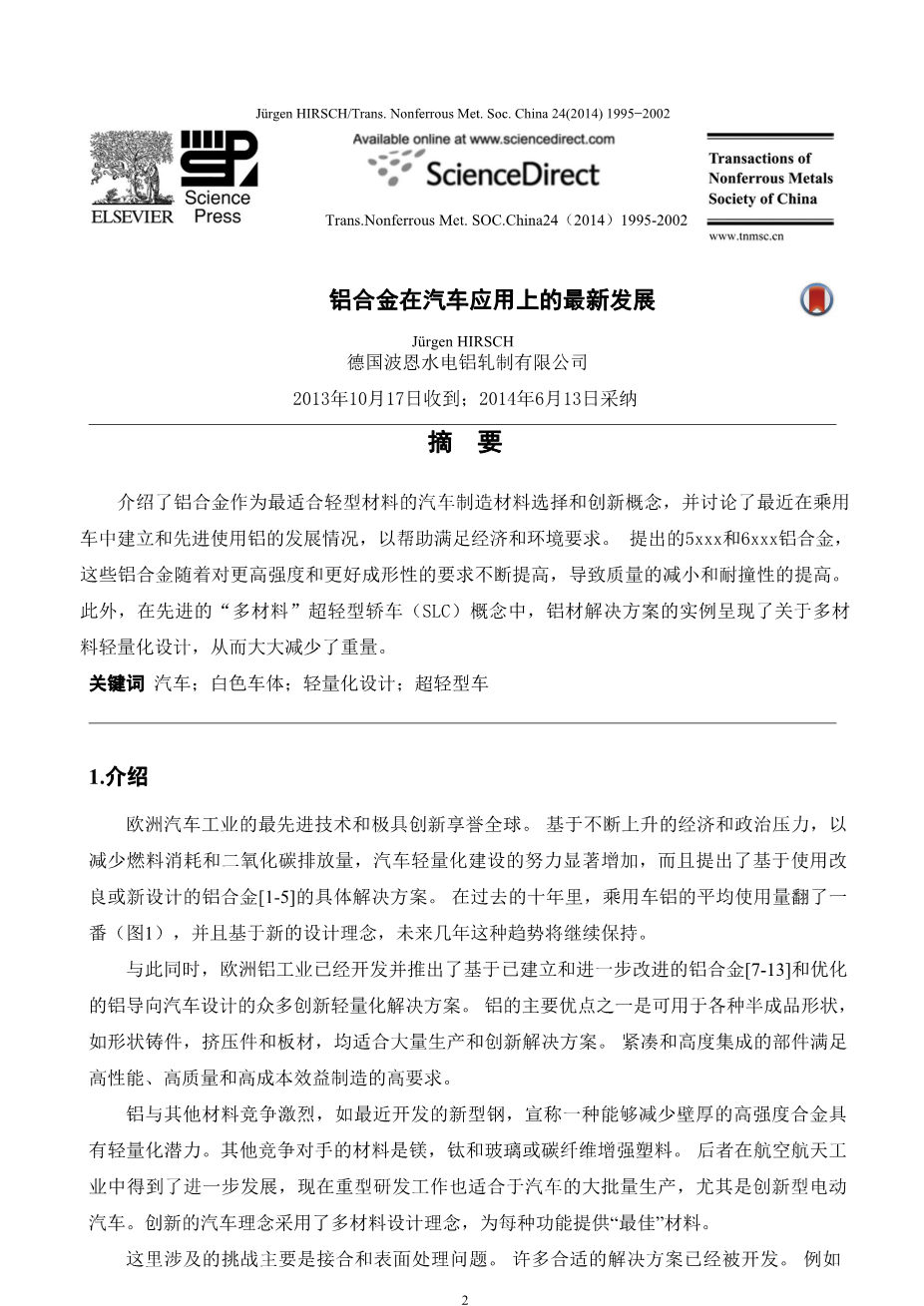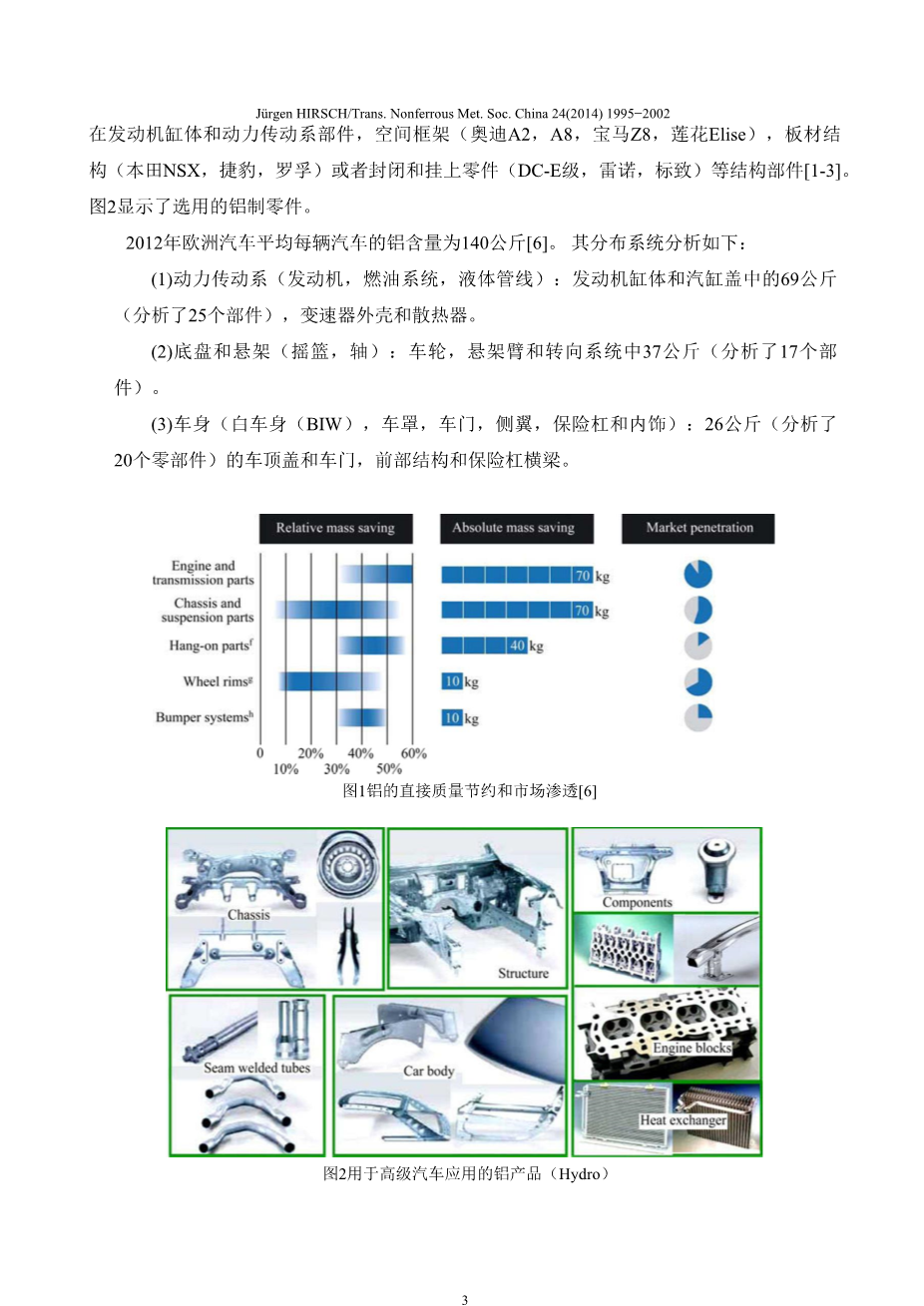Trans. Nonferrous Met. Soc. China 24(2014) 1995−2002
Recent development in aluminium for automotive applications
Jürgen HIRSCH
Hydro Aluminium Rolled Products GmbH, Ramp;D Bonn, Germany
Received 17 October 2013; accepted 13 June 2014
Abstract: Aspects of material selection and innovative concepts of car construction using aluminium as best suited light-weight materials were presented, and recent development in established and advanced use of aluminium in passenger cars was discussed that help to meet economic and environmental requirements. 5xxx and 6xxx aluminium alloys were presented that have been improved for the increasing demands regarding higher strength and better formability, resulting in a mass reduction and improved crashworthiness. Furthermore, advances concerning multi-material light weight design were presented by examples for aluminium solutions in advanced “Multi-material” Super-Light-Car (SLC) concepts, which reaches significant mass reductions.
Key words: automobile; body-in-white; light weight design; super-light-car
1 Introduction
The European automotive industry is known worldwide as technically most advanced and highly innovative. Based on rising economic and political pressure to reduce fuel consumption and CO2-emissions, the efforts for automotive lightweight construction have increased significantly and specific solutions are proposed based on the use of modified or newly designed aluminium alloys [1−5]. During the last decade the average amount of aluminium used in passenger cars has doubled (Fig. 1), and based on the new design concepts progress will keep on following this trend in the coming years.
In parallel the European aluminium industry has developed and introduced numerous innovative light-weight solutions based on the established and further improved aluminium alloys [7−13] and optimized aluminium-oriented car design. One of the main advantages of aluminium is its availability in a large variety of semi-finished forms, such as shape castings, extrusions and sheet, all suitable for mass production and innovative solutions. Compact and highly integrated parts meet the high demands for high performance, quality and cost efficient manufacturability.
Aluminium is in fierce competitive with other materials, like novel steels recently developed, claiming back the light weight potential by higher strength alloys
suitable for reducing wall thickness. Other competitor materials are magnesium, titanium and glass or carbon fibre reinforced plastics. The latter has developed further in the aerospace industries, now heavy Ramp;D efforts are made suitable for mass production also for cars, especially innovative electro cars. Innovative car concepts have adopted the multi-material design idea to use for each function the “best” material available.
Challenges involved here are mainly joining and surface treatment issues. Many suitable solutions have been developed. Application of semi-finished aluminium parts increases, e.g. in engine blocks and power train parts, space frames (Audi A2, A8, BMW Z8, Lotus Elise), sheet structures (Honda NSX, Jaguar, Rover) or as closures and hang-on parts (DC-E-class, Renault, Peugeot) and other structural components [1−3]. Figure 2 shows a selection of aluminium parts used.
The average total aluminium content per car for European cars was 140 kg in 2012 [6]. Its distribution has been analyzed systematically as:
- Power-train (engine, fuel system, liquid lines): 69 kg (25 components analysed) in engine block and cylinder head, transmission housings and radiators.
- Chassis and suspension (cradle, axle): 37 kg (17 components analysed) in wheels, suspension arms and steering systems.
- Car body (body-in-white (BIW), hoods, doors, wings, bumpers and interiors): 26 kg (20 components analysed) in bonnets and doors, front structure and
Corresponding author: Jürgen HIRSCH; Tel: 49-228-552-2704; Fax: 49-228-552-2017; E-mail: Juergen.Hirsch@hydro.com
DOI: 10.1016/S1003-6326(14)63305-7
1996 Jürgen HIRSCH/Trans. Nonferrous Met. Soc. China 24(2014) 1995−2002
Fig. 1 Aluminium’s direct mass savings and market penetration [6]
Fig. 2 Aluminium products for advanced automotive applications (Hydro)
bumper beams.
The analysis of the average compound annual growth rate (CAGR) indicates that for the body the highest potential exists [10]. Seen as one component the BIW is the heaviest part of a conventional car with a share of between 25% and 30% of the complete car’s mass, depending mainly on options installed, engine size, and integrated safety features.
- State-of-the-art design strategies for body-in-white (BIW)
There are two principal variants as state-of-the-art for a BIW design.
1) “Extrusion space-frame design” for small to medium volume cars: The AUDI A8 (e.g. D3, model year 2002, Fig. 3(b)) is a classical example with a scheduled volume of 25000 cars/year, a BIW mass of 277 kg; consisting of 59 extrusions (61 kg), 31 castings
(39 kg) and 170 sheet parts (177 kg). Riveting, MIG-, laser-, and hybrid welds, roll-folding and adhesive bonding are the main joining methods applied here.
2) “Stamped sheet monocoque” for medium to large volume cars, for example, the Jaguar XJ (X350), model year 2002 (Fig. 4), with 30000 cars/year and a BIW mass of 295 kg; consisting of 22 extrusions (21 kg), 15 castings (15 kg), and 273 sheet (259 kg). Joining methods are adhesive bonding, riveting, clinching and MIG welding.
3 Aluminium alloys for car body applications
3.1 Age-hardening Al−Mg−Si alloys
6xxx series alloys contain magnesium a
剩余内容已隐藏,支付完成后下载完整资料


英语译文共 12 页,剩余内容已隐藏,支付完成后下载完整资料
资料编号:[478748],资料为PDF文档或Word文档,PDF文档可免费转换为Word


